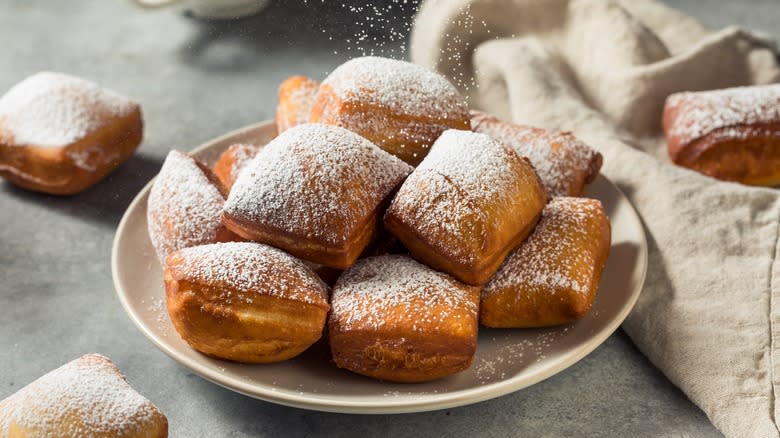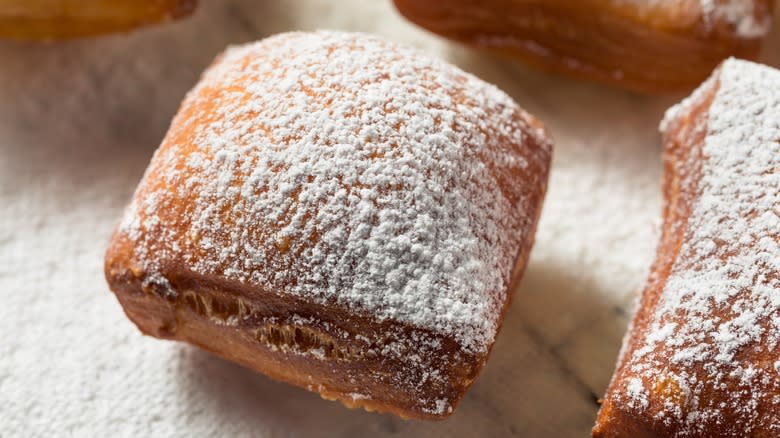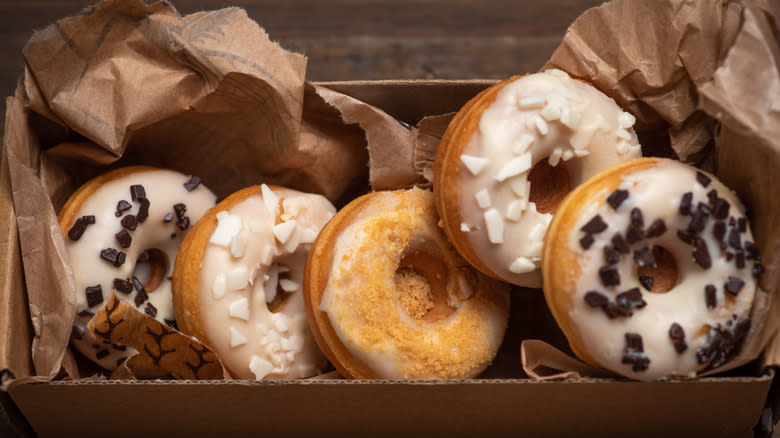Sweet, fried dough is a delicious treat no matter what you call it. Frosted with chocolate icing, dusted with powdered sugar, filled with pastry cream, square-shaped or circle-shaped -- it's all just some form of a donut, right? Not so fast. There are many varieties of fried dough pastries out there and when it comes to names, it's more than semantics. There are differences in these treats, from ingredients to presentation, that make them stand out from each other. This is true with donuts and beignets, as well.
At first glance, donuts and beignets may seem similar. They're similarly priced and fall into the same food group, with one having a fancy French name. But it turns out that while donuts and beignets may be close cousins, they're not identical. From specific ingredients to dough density to shape and toppings, donuts and beignets are two different pastries, even if they are equally tasty. If you're curious whether you're biting into this sweet breakfast treat's American or French version, here's how to tell.
Read more: Chocolate Brands, Ranked Worst To Best
What Is A Beignet?
A beignet is a sweet fried dough with origins in the fine pastry capital of the world: France. It's also common to find these in areas with heavy French influence, like New Orleans, where they are ubiquitous. These square-shaped pastries are served hot and fresh with a light dusting of powdered sugar -- and usually nothing else. They're often eaten for breakfast and alongside a cup of coffee but can be served as dessert as well.
ADVERTIsem*nT
The most common recipes for beignets use a French pastry dough known as choux pastry, which consists of water, flour, butter, and egg -- the same dough used to make cream puffs. The dough is cooked by deep frying, but no leavening agent like yeast or baking soda is used; instead, steam that forms within the pastry during cooking allows it to rise and get its airy texture.
What Is A Donut?
Donuts are another type of fried dough that are particularly popular in the U.S., though different variations of donuts can be found in countries and cultures around the world from Denmark to England and beyond. Classic donuts are known for their circular ring shape, though filled versions are typically solid circles or ovals. As for when they're consumed, Americans, particularly, eat themfor breakfast with coffee or milk.
Donuts come in a wide array of flavors, like chocolate, Boston creme, and powdered jelly, and are sometimes glazed with icing and topped with additional ingredients, from sprinkles to bacon to powder. Fried donuts are most frequently made with a loose and wet yeasted dough that gets cooked in a deep fryer before glazing, topping, and serving. The leavened dough typically includes flour, butter, sugar, eggs, and milk or water along with the yeast.
Beignets Are Square-Shaped
One key difference and easy identifier of beignets is the shape. Rather than the quintessential ring or circle shape associated with American donuts, beignets are square-shaped. (Though on rare occasions you may find beignets that are more ball-shaped).
Another telltale sign is whether your sweet pastry is loaded with fillings, flavors, icings, or toppings. Beignets are not glazed or coated in icing, nor are they typically filled with creams or jams (though they are occasionally accompanied by a sweet sauce). It's rare that you'd ever walk into a classic American donut shop and find square-shaped pastries in the display cases. If you're looking for a square, powdered sugar-coated beignet, you'll need to leave the donut shop and seek out a French bakery.
On the other hand, donuts are most often ring-shaped. Some, usually the filled ones, are solid circles, while others, like Long Johns, are longer and rectangular-shaped. And of course, there's the classic ball-shaped donut hole.
Donuts Are Denser
The texture of donuts and beignets is different due to the ingredients used. While both of these pastries fall on the side of light and fluffy, donuts are typically more dense than beignets. This is in part because of the difference in the dough; donuts aren't made with choux pastry like beignets. Instead, most donut recipes call for more eggs, making them heavier, while beignets are quite fluffy and airy after frying.
The donut's density is also thanks to the extras that donuts often get. Icings and toppings add a good deal of weight to donuts, not to mention extra sweetness and richness. If you're hankering for a pastry that's airy, simple, sweet, and delicious, seek out a beignet. But if you want to indulge in the denser, sweeter, richer bite of a donut, find yourself a donut shop to satisfy your tastebuds.
Read the original article on Tasting Table.




